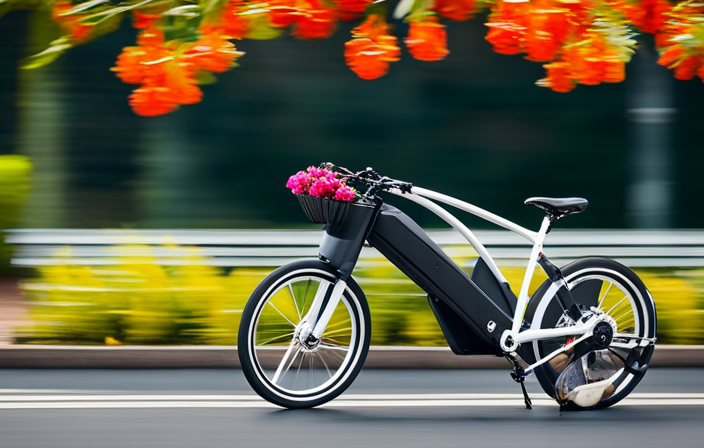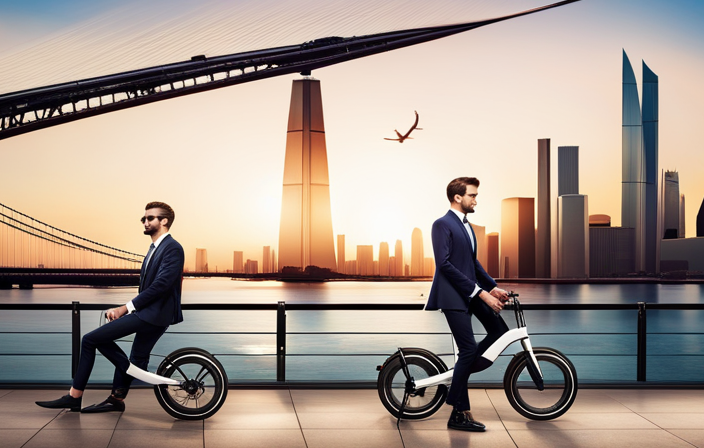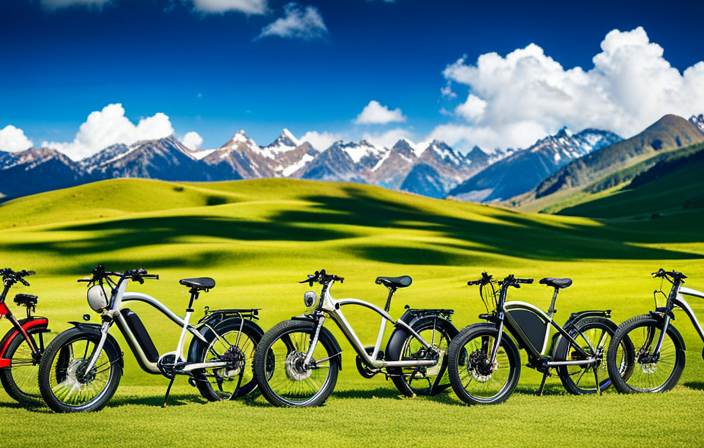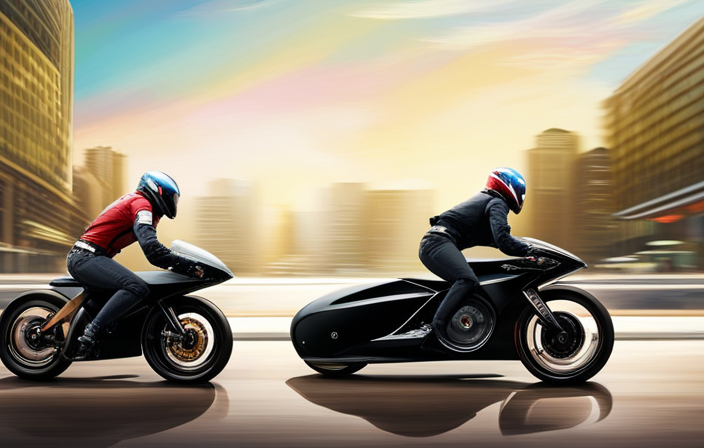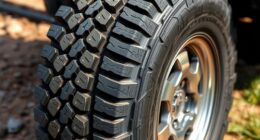As a passionate electric bike fan, I have developed a deep appreciation for the impressive longevity that these machines are capable of. Just like humans, electric bikes possess individual lifespans that are impacted by a range of factors.
From the quality of components to regular maintenance habits, several key elements impact how long an electric bike can ride the roads with power and efficiency.
In this article, we’ll delve into the intricate details that determine the lifespan of an electric bike, providing you with valuable insights to make informed decisions and prolong the life of your two-wheeled companion.
Key Takeaways
- The lifespan of an electric bike is influenced by factors such as the quality of components and construction, frequency and quality of maintenance, riding conditions and terrain, and battery usage and charging habits.
- Regular maintenance and repairs are important for prolonging the lifespan of an electric bike, and addressing issues promptly can prevent further damage.
- The type of battery, charging habits, and maintenance practices can significantly impact the battery lifespan, and tips for maximizing battery longevity should be followed.
- The motor lifespan of an electric bike can be influenced by factors such as the type of motor, wear and tear on components, and the impact of riding on different terrains.
Quality of Components
The lifespan of an electric bike can vary depending on the quality of its components. High-quality components are designed to withstand the demands of daily use and are less likely to fail prematurely. Common component failures such as motor burnouts, battery malfunctions, or brake issues are more likely to occur with low-quality components. To ensure a longer lifespan for your electric bike, it is essential to invest in high-quality components and perform regular maintenance.
Regularly inspecting the bike for any signs of wear and tear, keeping the components clean, and following proper maintenance tips can help prevent common component failures. By taking these maintenance habits seriously, you can significantly extend the lifespan of your electric bike.
Maintenance Habits
To maximize its longevity, make sure you regularly maintain your e-bike. Proper maintenance habits can significantly extend the lifespan of your electric bike. Here are some key points to keep in mind:
-
Upgrading components: Consider upgrading certain components of your e-bike, such as the brakes or gears, to improve overall performance and durability.
-
Common maintenance mistakes: Avoid making common maintenance mistakes, such as neglecting to clean and lubricate the chain regularly or failing to tighten loose bolts and screws.
-
Regular inspections: Perform regular inspections of your e-bike to identify any potential issues before they become major problems.
By following these maintenance habits, you can ensure that your electric bike remains in optimal condition for a longer period of time.
Now let’s discuss the next section on the lifespan of the battery.
Battery Lifespan
When it comes to the lifespan of an electric bike battery, there are several key factors that can affect its longevity. These factors include the type of battery used, the charging and discharging habits, and the overall maintenance of the battery.
To maximize the lifespan of the battery, it is important to follow certain tips. These include avoiding overcharging, storing the battery in a cool and dry place, and performing regular maintenance checks.
If the battery does eventually need to be replaced or upgraded, it is important to choose a compatible battery that meets the specifications of the electric bike.
Factors that affect battery life
Keep in mind that factors like riding style and terrain can impact how long your electric bike’s battery lasts.
Battery charging and power consumption are two key factors that affect the overall lifespan of an electric bike’s battery.
When it comes to battery charging, it’s important to follow the manufacturer’s guidelines and recommendations. Overcharging or undercharging the battery can lead to decreased battery life.
Additionally, power consumption plays a crucial role in battery lifespan. Riding at higher speeds or using the bike’s motor frequently can drain the battery faster. It’s important to find a balance between power usage and battery conservation.
By understanding these factors and making informed choices, you can maximize the lifespan of your electric bike’s battery.
Now, let’s explore some tips for maximizing battery lifespan.
Tips for maximizing battery lifespan
To make your battery last longer, you should implement these tips for maximizing its lifespan.
-
When it comes to battery charging, it is important to avoid overcharging or undercharging. It is best to charge the battery to its full capacity and then unplug it.
-
Additionally, try to avoid charging the battery at extremely high or low temperatures, as this can negatively impact its lifespan.
-
Proper battery storage is also crucial. If you won’t be using your electric bike for an extended period, make sure to store the battery in a cool and dry place. It is recommended to charge the battery to around 50% before storing it.
By following these guidelines for battery charging and storage, you can ensure that your electric bike’s battery lasts longer.
Now, let’s move on to the next section about replacing or upgrading the battery.
Replacing or upgrading the battery
When it comes to electric bike batteries, maximizing their lifespan is crucial. However, there may come a time when you need to consider replacing or upgrading your battery.
The lifespan of an electric bike battery can vary depending on factors such as usage, maintenance, and the quality of the battery itself. When it’s time to replace your battery, you’ll want to consider the cost of a new one. Battery replacement costs can vary depending on the brand and model of your electric bike.
Additionally, you may also want to explore battery upgrade options. Upgrading your battery can provide you with longer range and improved performance. Consider factors such as battery capacity and voltage when choosing an upgrade.
Now, let’s delve into the next section about the lifespan of the electric bike’s motor.
Motor Lifespan
Don’t worry about the motor lifespan of your electric bike. The motor performance and efficiency are designed to withstand years of use. Here are some key factors to consider:
- Motor Type: Choose a brushless motor for higher efficiency and longer lifespan.
- Power Output: Opt for a motor with sufficient power to handle your riding needs without straining.
- Maintenance: Regularly check and clean the motor to ensure optimal performance.
- Heat Dissipation: Proper cooling mechanisms, such as heat sinks, can extend the motor’s lifespan.
Understanding these aspects will help you make informed decisions when purchasing an electric bike.
Now, let’s delve into the wear and tear on components, which can affect the overall longevity of your electric bike.
Wear and Tear on Components
Considering the wear and tear on various components is essential to ensure the longevity of your electric bike. One component that experiences significant wear and tear is the tires. As the only point of contact with the road, the tires bear the brunt of the impact and friction during rides.
Regularly inspecting the tread depth and overall condition of the tires is crucial to prevent accidents and extend their lifespan. Additionally, your riding style can greatly affect the wear and tear on the tires. Aggressive riders who frequently perform sharp turns or hard stops put more strain on the tires, causing them to wear out faster. It is important to adjust your riding style accordingly to minimize the impact on your electric bike’s tires.
Transitioning into the subsequent section about riding conditions, it is equally important to consider the impact of different terrains and weather conditions on your electric bike’s lifespan.
Riding Conditions
When it comes to riding an electric bike, the terrain you choose to traverse can have a significant impact on the lifespan of its components.
Riding on rough terrains, such as mountain trails or unpaved roads, can result in increased wear and tear on the bike’s suspension, tires, and drivetrain.
Additionally, weather conditions can also play a role in the bike’s longevity. Exposure to rain, snow, and extreme temperatures can cause rust, corrosion, and damage to the electrical components of the bike.
Therefore, it is crucial to store and protect the bike from these harsh conditions to ensure its optimal performance and lifespan.
Impact of riding on different terrains
Riding an electric bike on different terrains can have a significant impact on its lifespan. The type of terrain you ride on can greatly affect the wear and tear on the bike’s components. For instance, riding on rough or uneven surfaces such as gravel or dirt trails can put more strain on the motor, battery, and suspension system. These components have to work harder to maintain stability and absorb the impact, which can lead to increased wear and reduced lifespan.
Additionally, riding on hilly terrains requires the motor to work harder, potentially leading to faster battery drain and increased heat generation. Extreme weather conditions like heavy rain or snow can also affect the bike’s lifespan by exposing it to moisture and potentially causing damage to electronic components.
Transitioning into the subsequent section, weather conditions have a crucial role in determining the overall lifespan of an electric bike.
Effect of weather conditions on bike lifespan
Weather conditions play a crucial role in how long your bike will last. Different weather elements can significantly impact the performance and lifespan of an electric bike. Altitude, for example, can affect the bike’s performance as higher elevations result in reduced air density, which can make it harder for the motor to propel the bike forward. Additionally, humidity can have a detrimental effect on the bike’s electronics, causing corrosion and potentially leading to malfunctions. To further illustrate the effects of weather conditions, consider the following table:
| Weather Condition | Effect on Bike Lifespan |
|---|---|
| High Altitude | Reduced Performance |
| High Humidity | Electronics Damage |
| Extreme Temperatures | Battery Degradation |
| Heavy Rainfall | Water Damage |
Understanding these effects is crucial for maintaining and prolonging the lifespan of your electric bike. Properly storing and protecting the bike from harsh conditions is essential.
Storing and protecting the bike from harsh conditions
To ensure the longevity of your bike, it’s important to properly store and protect it from harsh conditions.
One of the best ways to protect your electric bike is by using protective gear. A good quality bike cover can shield the bike from rain, snow, and UV rays that can cause damage over time.
Additionally, investing in a storage solution such as a bike shed or garage can provide extra protection from extreme weather conditions. It’s crucial to keep the bike in a dry and cool environment to prevent rust and corrosion.
Regularly cleaning the bike and applying lubricant to the chain and other moving parts can also help maintain its performance and extend its lifespan.
By taking these precautions, you can ensure that your electric bike remains in optimal condition for years to come.
Now, let’s delve into the next section about the frequency and distance of use.
Frequency and Distance of Use
When it comes to the frequency and distance of use, it’s important to consider how often and how far I ride my electric bike. Heavy usage can have a significant impact on the lifespan of the bike, as the components may wear out more quickly.
Finding the right balance between leisure and commuting use is crucial to ensure that my electric bike remains in optimal condition for as long as possible.
How often and how far you ride
On average, riders typically gauge their electric bike’s lifespan based on how often and how far they ride. The frequency and distance of use play a crucial role in determining the longevity of an electric bike. Here are four key factors to consider:
-
Balancing leisure and commuting use: Using your electric bike for both leisure rides and daily commutes can increase wear and tear. It is essential to strike a balance between these two types of usage to prolong the lifespan of your bike.
-
Weight capacity: Overloading your electric bike can put excessive strain on its components, leading to premature wear. Make sure to stay within the recommended weight capacity to prevent any potential damage.
-
Terrain and riding conditions: Riding on rough terrains and challenging conditions can accelerate the aging process of your electric bike. Regular maintenance and proper care are crucial to mitigate the impact of these factors.
-
Battery management: The battery is a vital component of an electric bike. Proper charging and discharging practices, along with regular battery maintenance, can significantly extend its lifespan.
Understanding how these factors affect the lifespan of your electric bike is essential. In the next section, we will explore the impact of heavy usage on bike lifespan.
Impact of heavy usage on bike lifespan
When it comes to electric bikes, heavy usage can have a significant impact on their lifespan. Riding your bike frequently and for long distances puts a strain on its components, causing them to wear out faster. This can lead to decreased performance and a shorter overall lifespan for the bike. One of the key areas affected by heavy usage is the battery efficiency. The more you ride, the more you drain the battery, and over time, its capacity may diminish. Additionally, the constant use of the motor and the increased load on the bike can also result in decreased performance. To ensure a longer lifespan for your electric bike, it is important to balance between leisure and commuting use, which I will discuss in the next section.
Balancing between leisure and commuting use
To ensure your e-bike lasts longer, it’s important to find a balance between using it for leisure activities and commuting. While using your electric bike for leisure rides can be enjoyable, it’s crucial to remember that heavy usage can impact its overall lifespan.
To maintain your e-bike’s longevity, it’s essential to follow a regular maintenance schedule. This includes checking the tire pressure, lubricating the chain, and inspecting the brakes regularly. Additionally, keeping up with routine maintenance can help identify any potential issues before they become major problems, ultimately reducing the cost of ownership.
By striking a balance between leisure and commuting use, and implementing a thorough maintenance routine, you can ensure that your e-bike remains in optimal condition for years to come.
This will also allow you to transition smoothly into the next section about weight capacity.
Weight Capacity
You can determine the weight capacity of an electric bike by checking its specifications. This is an important consideration when choosing an electric bike as it determines the maximum load capacity the bike can handle.
The weight capacity will vary depending on the brand and model of the electric bike. When looking at the weight capacity, it is also important to consider weight distribution. Some electric bikes may have a higher weight capacity but may not distribute the weight evenly, which can affect the bike’s stability and performance.
When considering an electric bike for leisure and commuting use, it is crucial to choose one that can accommodate your weight and ensure a safe and comfortable ride.
Now, let’s move on to the next section about brand and model.
Brand and Model
If you’re considering purchasing an electric bike, it’s important to research and compare different brand and model options. One key factor to consider is the brand reputation. Look for brands that have been in the market for a while and have a positive reputation for producing high-quality electric bikes.
Reading customer reviews can also provide valuable insights into the performance and reliability of a specific brand and model. Pay attention to reviews that mention the battery life, motor power, and overall durability.
It’s important to choose an electric bike that suits your needs and preferences, and selecting a reputable brand with positive customer reviews can help ensure you’re making a wise investment.
When it comes to regular maintenance and repairs, there are a few steps you can take to keep your electric bike in top shape.
Regular Maintenance and Repairs
Regular check-ups and tune-ups are crucial for maintaining the optimal performance of an electric bike. By regularly inspecting and servicing the bike, potential issues can be identified and addressed promptly, preventing further damage and costly repairs.
It is important to find a reliable electric bike repair shop that specializes in handling electric bike repairs to ensure that any maintenance or repairs are done correctly and efficiently.
Importance of regular check-ups and tune-ups
Having regular check-ups and tune-ups is important for maintaining the lifespan of an electric bike. By ensuring that your bike receives regular maintenance, you can extend its longevity and enhance its performance. Here are five compelling reasons why regular check-ups and tune-ups are crucial:
Improved safety: Regular maintenance helps identify and address potential safety issues, such as loose brakes or worn-out tires, ensuring a safer riding experience.
Enhanced efficiency: Professional tune-ups optimize the bike’s components, such as the motor and battery, improving its overall efficiency and extending the range.
Prevention of major repairs: Regular check-ups allow mechanics to identify minor issues before they escalate into costly repairs, saving you both time and money.
Prolonged battery life: Proper maintenance, including regular charging and battery inspections, helps maximize the lifespan of your e-bike’s battery.
Peace of mind: With regular maintenance, you can ride confidently, knowing that your bike is in optimal condition and less likely to encounter unexpected breakdowns.
By addressing issues promptly to prevent further damage, you can ensure that your electric bike remains in top shape for years to come.
Addressing issues promptly to prevent further damage
Regular check-ups and tune-ups are crucial for maintaining the performance and longevity of an electric bike. However, even with regular maintenance, issues can arise unexpectedly. It is important to address these issues promptly to prevent further damage and ensure the smooth operation of the electric bike.
As a knowledgeable electric bike enthusiast, I understand the technical intricacies involved in troubleshooting and resolving customer complaints. By promptly addressing these issues, we not only improve customer service but also extend the lifespan of the electric bike. Whether it’s a faulty motor, a malfunctioning battery, or any other problem, our expertise allows us to diagnose and fix the issue efficiently. This proactive approach not only saves time and money for the customer but also ensures their continued satisfaction.
Transitioning into the subsequent section, finding a reliable electric bike repair shop is the next step in ensuring the long-term performance of your electric bike.
Finding a reliable electric bike repair shop
When it comes to maintaining your e-bike, it’s important to find a trustworthy repair shop that can provide reliable services. This ensures that any issues with your electric bike are addressed promptly and efficiently. Here are some key factors to consider when finding a reliable electric bike repair shop:
-
Look for a shop that specializes in electric bikes, as they will have the expertise and experience needed to diagnose and fix any problems.
-
Check for customer reviews and ratings to gauge the shop’s reputation and reliability.
-
Compare prices to find affordable repair services without compromising on quality.
-
Inquire about warranty coverage and if the shop uses genuine parts for repairs.
-
Consider learning some DIY repair and maintenance tips to handle basic issues and keep your e-bike in good shape.
By finding a reliable electric bike repair shop and incorporating some DIY repair and maintenance tips, you can ensure the longevity of your e-bike while keeping costs reasonable.
Frequently Asked Questions
How often should I replace the battery of an electric bike?
I recommend replacing the battery of an electric bike every 2-3 years, depending on usage. It’s important to monitor battery life and charging frequency to ensure optimal performance and avoid any unexpected power issues during rides.
Can I use my electric bike in rainy or snowy conditions?
Yes, you can ride an electric bike in rainy or snowy conditions. To protect it from water damage, ensure all electrical connections are sealed, use fenders, and consider applying a waterproof coating to the frame and components.
What is the average weight capacity of an electric bike?
The average weight capacity of an electric bike is typically around 250-300 pounds, but some models can handle up to 400 pounds. When comparing electric bike weight limits, it’s important to consider factors like frame strength and motor power.
Does the brand and model of an electric bike affect its lifespan?
The brand and model of an electric bike can significantly impact its lifespan. Factors such as build quality, components, and overall design can determine electric bike durability. Additionally, the frequency and intensity of usage also play a crucial role in determining the lifespan of an electric bike.
Is it necessary to perform regular maintenance and repairs on an electric bike?
Regular maintenance and repairs are crucial for the optimal performance and longevity of an electric bike. Neglecting these tasks can lead to a decrease in efficiency and potential damage to the bike’s components.
Conclusion
In conclusion, the lifespan of an electric bike depends on various factors. These factors include the quality of components, maintenance habits, battery and motor lifespan, wear and tear on components, frequency and distance of use, weight capacity, and brand and model.
It is essential to regularly maintain and repair your electric bike to ensure its longevity. By doing so, you can prevent major issues down the road. Remember the saying, ‘a stitch in time saves nine.’ This means that taking care of your electric bike early on can save you from having to deal with more significant problems later.
So, keep pedaling and enjoying the smooth ride of your electric steed for years to come.
